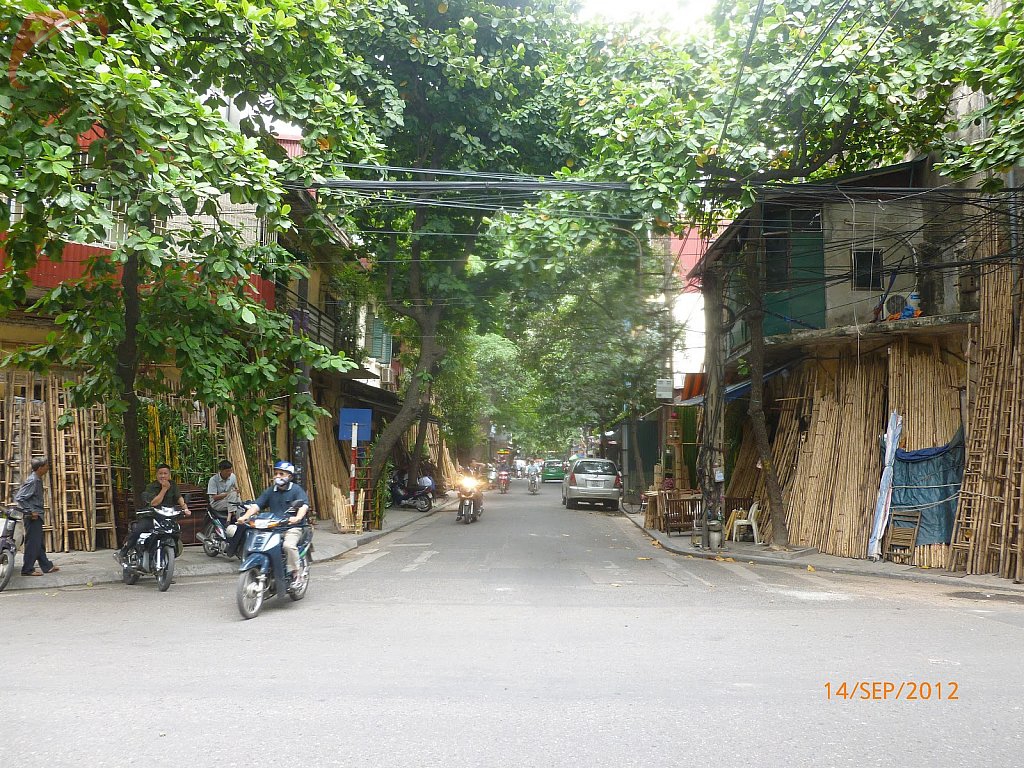
Hanoi photos
Bamboo street (Pho Hang Tre)
Pho Hang Tre or Bamboo street is one of the traditional streei in the Old Quarter, also called "Hanoi 36 Pho Phuong" or the “City of Thirty Six Streets and Guilds” took shape in the 15th century, with evocative place names like Silk Street, Noodle Street, Hemp Street, Cotton Street, Sail Street, Coffin Street, Mat Street, Bowl Street, Medicinal Herb Street, Votive Offering Street, Grilled Fish Street, etc. There life boils over onto the pavement.
But rare are those streets which still retain some vestige of their former activities. On the other hand, a new sort of “Thirty Six Streets and Guilds” has emerged in the context of the market economy.
Here is a guide for provincials and curious foreigners:
Eateries: stewed chicken (Cấm Chỉ and Kỳ Đồng), chicken feet (Hàng Dau), beer (Nguyễn Du and Hàm Long streets), pastry (Hàng Bổng Nhuộm), dog meat (Nghi Tàm), confectionery and cigarettes (Hàng Buồm), Sino- Vietnamese foods (Tạ Hien).
Consumer goods: bicycles (Bà Triệu), motorbikes (Phùng Hưng), motorbike parts (Phô Huề), building materials (Cát Linh), scrap iron (Dê La Thành), western medicines (Văn Miếu, Lê Duẩn), sandals (Hàng Dấu), dry goods (Phùng Khắc Khoan), toys (Lương Văn Can), carpets (Ngô Văn Sở), artificial flowers, chinaware and Chinese-made furniture (Hàm Long), garments (Khám Thiên, Hàng Đào), foam rubber pillows and mattresses (Hàng Điếu), electric appliances (Lê Duẩn), backpacks and briefcases (Đinh Tiên Hoàng).
Services: pavement massage (Nguyễn Thái Học, near Của Nam), women’s wear (Lương Văn Can), cuưency exchange (Đinh Lễ), labour (Giảng Võ), motorbike wash (Trần Phú), car rental (Quang Trung, Tràng Thi), barbers (Quang Trung).
October 1993.
Pho Hang Tre or Bamboo street is one of the traditional streei in the Old Quarter, also called "Hanoi 36 Pho Phuong" or the “City of Thirty Six Streets and Guilds” took shape in the 15th century, with evocative place names like Silk Street, Noodle Street, Hemp Street, Cotton Street, Sail Street, Coffin Street, Mat Street, Bowl Street, Medicinal Herb Street, Votive Offering Street, Grilled Fish Street, etc. There life boils over onto the pavement.
But rare are those streets which still retain some vestige of their former activities. On the other hand, a new sort of “Thirty Six Streets and Guilds” has emerged in the context of the market economy.
Here is a guide for provincials and curious foreigners:
Eateries: stewed chicken (Cấm Chỉ and Kỳ Đồng), chicken feet (Hàng Dau), beer (Nguyễn Du and Hàm Long streets), pastry (Hàng Bổng Nhuộm), dog meat (Nghi Tàm), confectionery and cigarettes (Hàng Buồm), Sino- Vietnamese foods (Tạ Hien).
Consumer goods: bicycles (Bà Triệu), motorbikes (Phùng Hưng), motorbike parts (Phô Huề), building materials (Cát Linh), scrap iron (Dê La Thành), western medicines (Văn Miếu, Lê Duẩn), sandals (Hàng Dấu), dry goods (Phùng Khắc Khoan), toys (Lương Văn Can), carpets (Ngô Văn Sở), artificial flowers, chinaware and Chinese-made furniture (Hàm Long), garments (Khám Thiên, Hàng Đào), foam rubber pillows and mattresses (Hàng Điếu), electric appliances (Lê Duẩn), backpacks and briefcases (Đinh Tiên Hoàng).
Services: pavement massage (Nguyễn Thái Học, near Của Nam), women’s wear (Lương Văn Can), cuưency exchange (Đinh Lễ), labour (Giảng Võ), motorbike wash (Trần Phú), car rental (Quang Trung, Tràng Thi), barbers (Quang Trung).
October 1993.
